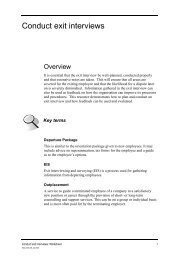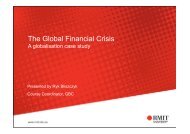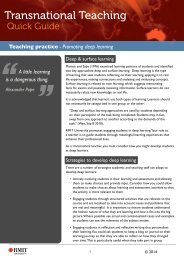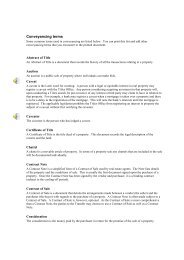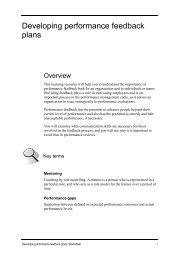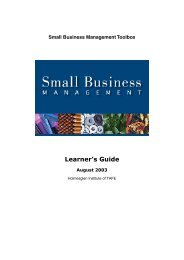Approaching student-centred learning and teaching - RMIT University
Approaching student-centred learning and teaching - RMIT University
Approaching student-centred learning and teaching - RMIT University
Create successful ePaper yourself
Turn your PDF publications into a flip-book with our unique Google optimized e-Paper software.
All academic <strong>and</strong> <strong>teaching</strong> staff must be sensitive to the impact that feelingsof anxiety, shame <strong>and</strong> embarrassment may have on a <strong>student</strong>’s willingness toengage in classroom activities. If <strong>teaching</strong> in a transnational setting, you needto be aware that in many societies respect for seniority <strong>and</strong> the need to savingface may impact on the level of confidence <strong>student</strong>s have in participating insome classroom activities. More information about how culture may impacton a <strong>student</strong>’s sense of psychological safety is available from the TransnationalTeaching Quick Guide <strong>Approaching</strong> cultural diversity.In 1968 Rosenthal <strong>and</strong> Jacobson demonstrated in their “Pygmalion in theClassroom” study that “teacher expectations can act as self-fulfilling propheciesbecause <strong>student</strong> achievement comes to reflect their expectations” (Pintrich &Schunk, 1996, p.347).Students need to feel part of their <strong>learning</strong> community <strong>and</strong> you must create anatmosphere that encourages them to support one another in their <strong>learning</strong>. Tocreate this sense of belonging in the group you need to encourage active communicationbetween <strong>student</strong>s through team work <strong>and</strong> communication activities,<strong>and</strong> through your own encouragement of them as part of your community.Build supportive & constructive teacher/<strong>student</strong>relationshipsA constructive teacher/<strong>student</strong> relationship is important for optimal<strong>learning</strong>. Students need to feel respected <strong>and</strong> that their <strong>learning</strong> needs areaccommodated. It can be difficult to get to know all <strong>student</strong>s personally if youhave a large class however even when you have a large class it is worth payingattention to both the common <strong>and</strong> diverse characteristics of the <strong>student</strong> group.When designing <strong>learning</strong> activities it is important to consider the diverse rangeof life experiences that <strong>student</strong>s bring to the classroom. These life experienceswill influence the way <strong>student</strong>s process new <strong>learning</strong>; they will often search formeaning <strong>and</strong> analyse <strong>and</strong> interpret the concepts <strong>and</strong> ideas you present basedon their past experiences <strong>and</strong> what they already know.You can gain an appreciation of your <strong>student</strong>s’ past <strong>learning</strong> <strong>and</strong> experiences byengaging them in dialogue about how their past <strong>learning</strong> <strong>and</strong> experiences mayshape the way they think about the knowledge <strong>and</strong> information you present.Vella (2001) presents some useful ideas on how you can do this. Examples ofquestions or tasks you use include asking <strong>student</strong>s to:• Think about how the topic relates to their own life experiences.• Identify something that st<strong>and</strong>s out for them in the new knowledgepresented.• Underline key words they would like to discuss with the group.• Engage in dialogue about the new knowledge.• Engage in an activity that helps them to construct their own content.2 © © 2014




